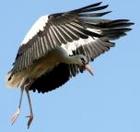 Storks returned to their old nests, but not necessarily to former partners
Storks returned to their old nests, but not necessarily to former partners
Storks returned to their nests in Poland. But they do not wait for the return of the former partner. If he or she shows up too late, there may no longer be a place in the nest - said Magdalena Zadrąg of the National Society for the Protection of Birds.
The ornithologist explained that every year the Polish storks return at
about the same time - in the second half of March. These birds leave
warmer countries when the length of the day changes. However, the main
factor in their time of arrival in Poland are weather conditions en
route. Bad weather on the way may delay their return.
"In the winter storks live in flocks. For example, in Egypt it is
difficult to find a place providing water and nourishment. If the birds
find such area, they gather there"- explained the researcher. Storks
leave warm countries in groups of several or several dozen birds. Over
time they separate, because each bird returns to a different place and
their groups are becoming smaller. By the time they arrive to Poland,
they fly individually or in couples that have found each other on the
way.
After returning to their old territories, storks must check
if the conditions are still good for feeding and if that their nests are
not occupied. They begin to search for their partners, because,
Magdalena Zadrąg noted, birds do not always return to Poland in couples.
"Storks become attached to their partners, but often overwinter in
different places. If any of the partners' return is delayed, it happens
that the faster bird does not wait long, and brings a new partner to the
nest"- said the researcher. "Storks are a couple, when they raise
offspring together and bring them food. But when the chicks begin to be
independent, partners lose interest in each other"- she explained.
After
returning to Poland, storks are rebuilding their old nests. "These are
carefully chosen of places, with a good view of the countryside and
inaccessible to predators" - explained Zadrąg. she explained that the
birds almost always renew the old nests or build entirely new nests on
top of old ones. Because of this, the nest may reach the weights of up
to several tons. It happens that storks do not find their nests. Their
breeding sites sometimes collapse under its own weight or have been
removed by people, as in the interests of safety people sometimes must
dispose of nests that could fall on a building are built on power lines.
"In
Poland, the majority of storks live in the northeast of the country -
in Mazury and in Suwalki region. There are plenty of feeding sites, and
people are very friendly towards them"- said Zadrąg. (PAP)
last modification: 2011-04-01













































 Storks returned to their old nests, but not necessarily to former partners
Storks returned to their old nests, but not necessarily to former partners